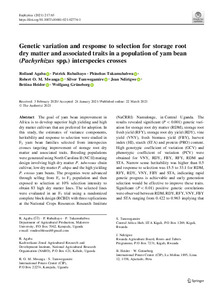| dc.contributor.author | Agaba, R. |
| dc.contributor.author | Rubaihayo, P. |
| dc.contributor.author | Tukamuhabwa, P. |
| dc.contributor.author | Mwanga, R.O. |
| dc.contributor.author | Tumwegamire, S. |
| dc.contributor.author | Ndirigwe, J. |
| dc.contributor.author | Heider, B. |
| dc.contributor.author | Gruneberg, W.J. |
| dc.date.accessioned | 2022-01-24T08:57:51Z |
| dc.date.available | 2022-01-24T08:57:51Z |
| dc.date.issued | 2021 |
| dc.identifier.citation | Agaba, R., Rubaihayo, P., Tukamuhabwa, P., Mwanga, R.O., Tumwegamire, S., Ndirigwe, J., ... & Gruneberg, W.J. (2021). Genetic variation and response to selection for storage root dry matter and associated traits in a population of yam bean (pachyrhizus spp.) interspecies crosses. Euphytica, 217(5), 1-12. . |
| dc.identifier.issn | 1573-5060 |
| dc.identifier.uri | https://hdl.handle.net/20.500.12478/7316 |
| dc.description.abstract | The goal of yam bean improvement in Africa is to develop superior high yielding and high dry matter cultivars that are preferred for adoption. In this study, the estimates of variance components, heritability and response to selection were studied in F3 yam bean families selected from interspecies crosses targeting improvement of storage root dry matter and associated traits. Breeding populations were generated using North Carolina II (NC II) mating design involving high dry matter P. tuberosus chuin cultivar, low dry matter P. ahipa and the high yielding P. erosus yam beans. The progenies were advanced through selfing from F1 to F2 population and then exposed to selection at 10% selection intensity to obtain 83 high dry matter lines. The selected lines were evaluated in an F3 trial using a randomized complete block design (RCBD) with three replications at the National Crops Resources Research Institute (NaCRRI) Namulonge, in Central Uganda. The results revealed significant (P < 0.001) genetic variation for storage root dry matter (RDM), storage root fresh yield (RFY), storage root dry yield (RDY), vine yield (VNY), fresh biomass yield (FBY), harvest index (HI), starch (STA) and protein (PRO) content. High genotypic coefficient of variation (GCV) and phenotypic coefficient of variation (PCV) were obtained for VNY, RDY, FBY, RFY, RDM and STA. Narrow sense heritability was higher than 0.5 and response to selection was 15.5 to 33.1 for RDM, RFY, RDY, VNY, FBY and STA, indicating rapid genetic progress is achievable and early generation selection would be effective to improve these traits. Significant (P < 0.01) positive genetic correlations were observed between RDM, RDY, RFY, VNY, FBY and STA ranging from 0.422 to 0.963 implying that simultaneous improvement of these traits is possible in the current yam bean populations. |
| dc.description.sponsorship | CGIAR Trust Fund |
| dc.description.sponsorship | Belgium Development Corporation |
| dc.description.sponsorship | Carnegie Corporation of New York |
| dc.format.extent | 1-12 |
| dc.language.iso | en |
| dc.subject | Genetics |
| dc.subject | Roots |
| dc.subject | Pachyrhizus Erosus |
| dc.title | Genetic variation and response to selection for storage root dry matter and associated traits in a population of yam bean (Pachyrhizus spp.) interspecies crosses |
| dc.type | Journal Article |
| cg.contributor.crp | Roots, Tubers and Bananas |
| cg.contributor.affiliation | Makerere University |
| cg.contributor.affiliation | National Agricultural Research Organisation, Uganda |
| cg.contributor.affiliation | International Potato Center |
| cg.contributor.affiliation | International Institute of Tropical Agriculture |
| cg.contributor.affiliation | Rwanda Agricultural Board |
| cg.coverage.region | Africa |
| cg.coverage.region | East Africa |
| cg.coverage.country | Uganda |
| cg.coverage.hub | Central Africa Hub |
| cg.researchtheme | Biotech and Plant Breeding |
| cg.identifier.bibtexciteid | AGABA:2021 |
| cg.isijournal | ISI Journal |
| cg.authorship.types | CGIAR and developing country institute |
| cg.iitasubject | Agronomy |
| cg.iitasubject | Food Security |
| cg.iitasubject | Plant Breeding |
| cg.iitasubject | Plant Production |
| cg.iitasubject | Yam |
| cg.journal | Euphytica |
| cg.notes | Published online: 22 Mar 2021 |
| cg.accessibilitystatus | Open Access |
| cg.reviewstatus | Peer Review |
| cg.usagerightslicense | Creative Commons Attribution 4.0 (CC BY 0.0) |
| cg.targetaudience | Scientists |
| cg.identifier.doi | https://doi.org/10.1007/s10681-021-02776-1 |
| cg.iitaauthor.identifier | Silver Tumwegamire: 0000-0003-2820-6337 |
| cg.futureupdate.required | No |
| cg.identifier.issue | 5 |
| cg.identifier.volume | 217 |
| cg.contributor.acknowledgements | This research was undertaken as part of, and funded by, the CGIAR Research Program on Roots, Tubers and Bananas (RTB) and supported by CGIAR Trust Fund contributors. Additional funding for was provided by Belgium Development Corporation (BTC) through International Potato Center (CIP), and Carnegie Corporation of New York through
the Regional Universities Forum for Capacity Building in Agriculture (RUFORUM). https://www.cgiar.org/funders/. |

